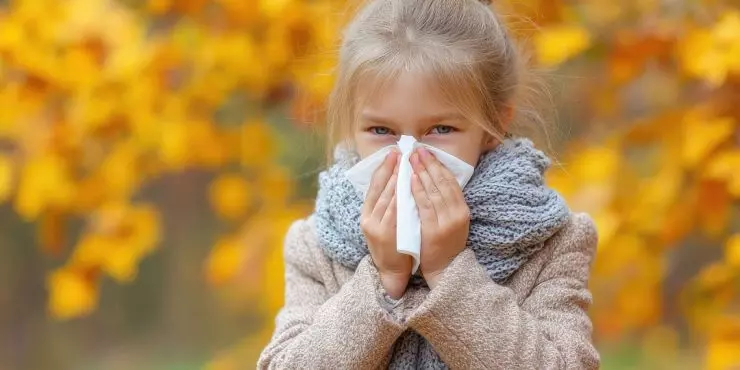
Every year, as the leaves start to change in Minnesota, many parents face a familiar pattern: their child suddenly seems to catch every sniffle, cough, and bug going around. If you're wondering why your child always gets sick in the fall—and what you can actually do about it—you're not alone.
At Northwest Family Clinics, with locations in Crystal, Plymouth, and Rogers, MN, our pediatricians hear this concern every autumn. The good news? There are clear reasons why it happens—and plenty of proactive ways to support your child’s immune system.
Why Kids Get Sick More Often in the Fall

Fall marks the return of school, changes in weather, and the beginning of cold and flu season. Here are a few key factors that contribute to the uptick in illnesses:
1. School and Daycare Exposure
Children are suddenly back in classrooms and shared indoor spaces where viruses spread easily. Close contact, shared supplies, and frequent touching of faces make it easy for germs to move from child to child.
2. Indoor Air and Dry Conditions
Cooler weather means closed windows and indoor heating systems—both of which can dry out nasal passages. This makes it easier for viruses to take hold and harder for the body to flush them out.
3. A Surge in Seasonal Viruses
Fall is the start of the respiratory virus season. This includes:
- Common colds (rhinoviruses, coronaviruses, adenoviruses)
- Influenza
- RSV (Respiratory Syncytial Virus)
- COVID-19
These viruses thrive in cooler, drier conditions and often circulate more actively in schools and childcare settings.
4. Weakened Immune Defenses
After a summer of fresh air, sunshine, and fewer germs, a child’s immune system may not be as primed to handle the sudden surge of fall viruses. Fatigue, stress, and poor sleep habits from the back-to-school transition can also play a role.
How to Help Your Child Stay Healthier This Fall

While you can’t completely prevent your child from getting sick, there are smart ways to strengthen their immune system and reduce the frequency and severity of illnesses.
1. Stay Up to Date on Vaccinations
Make sure your child is current on recommended vaccines, including:
- Annual flu shot
- COVID-19 boosters (if eligible)
- DTaP, MMR, and others per schedule
These vaccines are safe, effective, and one of the best ways to reduce serious illness. Find more information on vaccinations here, as we answer some of the most frequently asked questions.
2. Prioritize Sleep
Sleep isn’t just about rest—it’s when your child’s body gets to repair, restore, and recharge. During deep sleep, the immune system releases proteins called cytokines that help fight off infection and inflammation. Without enough sleep, the body has a harder time mounting a defense against viruses—especially during cold and flu season.
So how much is enough?
- Preschoolers (ages 3–5) need 10–13 hours of sleep every 24 hours, including naps.
- School-age children (ages 6–12) need 9–12 hours per night.
- Teens (13–18) benefit from 8–10 hours per night—though many don’t get it.
If your child is constantly getting sick in the fall, take a closer look at their sleep habits—especially after summer break routines shift.
Here are a few ways to support healthy sleep:
- Stick to a consistent bedtime and wake time, even on weekends. This helps regulate their internal clock.
- Limit screen time in the hour before bed. The blue light from tablets and TVs can delay melatonin release and make it harder to fall asleep.
- Create a calming bedtime routine. This might include a warm bath, reading together, dim lights, and quiet time—anything that signals to their body that it’s time to rest.
- Make their sleep space cozy and distraction-free. A cool, dark, and quiet room can help promote deeper, uninterrupted sleep.
- Watch for hidden sleep disruptors. Congestion, allergies, or even stress can interfere with sleep quality. If your child snores, wakes frequently, or seems overtired during the day, it may be worth mentioning to their pediatrician.
Sleep is one of the most powerful tools for a strong immune system. When kids are well-rested, they’re better equipped to fight off the wave of fall germs—and bounce back faster if they do catch something.
3. Reinforce Hand Hygiene
Teach children to wash their hands frequently—especially:
- Before eating
- After using the bathroom
- After coughing or sneezing
Remember, hand sanitizer is a good backup for on-the-go moments, but soap and water is best. Learn more about proper handwashing here.
4. Keep Them Hydrated and Well-Nourished H3
Water is one of the simplest ways to support your child’s immune system. It helps flush out toxins, keeps mucous membranes moist (making it harder for germs to take hold), and supports healthy digestion and energy levels.
Make sure your child is drinking plenty of fluids throughout the day—especially if they’re active or recovering from an illness. If plain water is a tough sell, try:
- Diluted 100% fruit juices (like orange or apple), be sure to watch the labels on these and choose an option with no sugar or sweetener added
- Coconut water (for a natural electrolyte boost)
- Warm broths or soups
- Herbal teas (such as chamomile, rooibos, ginger, fruit, or lemon balm, if age-appropriate)
- Add fresh fruit like limes, cucumbers, or oranges
When it comes to nourishing foods, aim for a colorful plate. Some of the best immune-boosting choices include:
Foods Rich in Vitamin C:
- Oranges, tangerines, and clementines
- Strawberries
- Kiwi
- Red bell peppers
- Tomatoes
- Broccoli
Foods High in Zinc:
- Pumpkin seeds
- Chickpeas (try them roasted or in hummus!)
- Cashews
- Whole grain cereals and breads
- Lean beef or turkey (if not vegetarian)
Other Immune-Friendly Picks:
- Yogurt with live probiotics (helps gut health, which is tied to immunity)
- Oats and whole grains for steady energy
- Spinach and leafy greens for a vitamin and mineral boost
- Carrots and sweet potatoes for beta carotene (a precursor to vitamin A)
The goal isn’t perfection—it’s variety and consistency. Offering a range of fruits, veggies, whole grains, and hydration options throughout the week goes a long way in helping your child’s body stay strong through sniffle season.
5. Don’t Overuse Antibiotics
Most fall illnesses—like colds and viral sore throats—are caused by viruses, not bacteria. Antibiotics won’t help and may contribute to resistance and destroy beneficial gut bacteria. When in doubt, talk to your family doctor to determine if antibiotics are truly needed.
6. Keep Sick Kids Home When Needed
It’s tough to miss work or school, but resting at home not only helps your child recover faster—it prevents spreading illness to others. Follow your school’s guidelines for returning after fever or other symptoms. Find more information on when to keep your child home sick from school here.
Minnesota-Specific Tips for Fall Illness Prevention
Fall in Minnesota brings beautiful scenery—but also a unique mix of weather conditions and allergens. Here are a few local insights:
Ragweed Allergies Can Weaken Defenses
Ragweed peaks in Minnesota from late August to October. For kids with seasonal allergies, inflamed airways can make it easier for viruses to cause secondary infections like sinusitis or ear infections. Talk to your provider about starting antihistamines or steroid nasal sprays early in the season.
Sudden Temperature Swings
Minnesota fall days can swing from 70°F to 40°F—and kids often aren’t dressed accordingly. Make sure your child wears layers and packs a jacket for chilly mornings to help avoid unnecessary cold stress on the body.
RSV Season Starts Early
Minnesota hospitals often see a rise in RSV cases as early as late September. Infants and toddlers are especially at risk, so talk to your pediatrician about new RSV prevention options like the nirsevimab (Bayforus) vaccine for eligible babies.
FAQs: Why Kids Get Sick in the Fall

Q: Is it normal for my child to get sick several times each fall?
A: Yes—especially for young children. It’s not unusual for kids to have 6–8 colds a year, and many of those happen in fall and winter.
Q: Should I send my child to school with a mild cough or runny nose?
A: It depends. If your child is fever-free, energetic, and symptoms are mild, most schools allow attendance. But if you’re unsure, call your provider or check with your school nurse.
Q: When should I be concerned about frequent illness?
A: If your child seems sick more often than their peers, isn’t recovering between illnesses, or has repeated ear infections or sinus infections, it may be time to investigate further with your family doctor.
Q: Does vitamin C or elderberry prevent illness?
A: While they may offer some immune support, the best prevention tools are still sleep, handwashing, healthy eating, and vaccines. Supplements should only be used with your provider’s guidance.
When to Call the Doctor
Contact your family physician if:
- Your child has a fever over 100.4°F for more than 3 days
- They’re showing signs of dehydration (dry lips, fewer wet diapers or bathroom trips)
- Breathing becomes difficult or wheezy
- Symptoms are getting worse instead of better after 5–7 days
- You’re simply unsure or need peace of mind
At Northwest Family Clinics, we’re here for your family every season. Whether it’s a lingering cough, ear infection, or just a back-to-school virus, our team in Crystal, Plymouth, and Rogers is ready to help your child feel better—and stay well.
Fall Illness Is Common—But Manageable
The fall sniffles might feel inevitable, but with a little preparation and support, your child can stay healthier and bounce back quicker. Remember—getting sick is part of building a strong immune system. And when you have a trusted family doctor on your side, you don’t have to go through it alone.